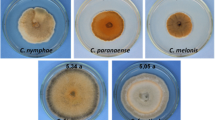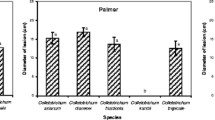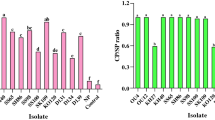Abstract
Glomerella leaf spot (GLS) is an apple disease that is causing concern to growers in Brazil due to the increases in severity over the years and the difficulties in control. To date there are few studies on the temporal progress of this disease specially comparing species of Colletotrichum. In Brasil the main species is C. fructicola followed by C. nymphaeae. It is not known the contribution of each species to the more or less aggressive behavior of the epidemic related to the different regions of apple production in Brazil. This study aimed to evaluate the temporal progress of GLS and to compare epidemiological differences between Colletotrichum species in two apple cultivars. After modeling disease progress in two plots of experiments assessing the curve for each leaf (300 curves/plot, 30 twigs with 10 leaves each), we recommend the use of the non-linear logistic model with random effects. The simulated temperature range of different producing regions in Brazil (under growth chamber) did not influence the severity of the disease caused by each species studied: C. nymphaeae, C. fructicola or C. karstii. Under controlled conditions of temperature and also in an experimental orchard, C. karstii did not cause GLS symptoms in ‘Eva’ and was less severe in ‘Gala’ when compared to C. nymphaeae and C. fructicola. Incubation period and latent period in ‘Gala’ were similar between C. nymphaeae and C. fructicola and greater when leaves were inoculated with C. karstii. In this study we demonstrated differences in GLS severity among species and between apple cultivars. We showed that the infection period and latent period are similar between C. fructicola and C. nymphaeae and they were equally severe at the same inoculation conditions. Cultivar Eva, classified as resistant to Colletotrichum spp., can be infected by C. fructicola and C. nymphaeae.




Similar content being viewed by others
References
Araujo, L., & Stadnik, M. J. (2013). Cultivar-specific and ulvaninduced resistance of apple plants to Glomerella leaf spot areassociated with enhanced activity of peroxidases. ActaScientiarum Agronomy, 35, 287–293.
Becker, W. F., Katsurayama, Y., & Boneti, J. I. S. (2000). Mancha foliar da Gala: principal doença de verão da cultura da macieira. Agropecuária Catarinense, 13, 14–20.
Bragança, C. D., Damm, U., Baroncelli, R., Massola Júnior, N. S., & Crous, P. W. (2016). Species of the Colletotrichum acutatum complex associated with anthracnose diseases of fruit in Brazil. Fungal Biology, 120, 547–561.
Chen, S. N., Luo, C. X., Hu, M. J., & Schnabel, G. (2016). Fitness and competitive ability of Botrytis cinerea isolates with resistance to multiple chemical classes of fungicides. Phytopathology, 106, 997–1005.
Damm, U., Cannon, P. F., Woudenberg, J. H. C., & Crous, P. W. (2012). The Colletotrichum acutatum species complex. Studies in Mycology, 73, 37–113.
Furlan, C. R. C., Dantas, A. C. D. M., Denardi, F., Becker, W. F., & Mantovani, A. (2010). Resistência genética dos acessos do banco de germoplasma de macieira da Epagri à mancha foliar de Glomerella (Colletotrichum gloeosporioides). Revista Brasileira de Fruticultura, 32, 507–514.
Hamada, N. A. (2013). A Epidemiologia da mancha foliar de glomerella em macieira (117p). Curitiba-PR: Tese.
Hamada, N. A., & May De Mio, L. L. (2017). Survival of pathogenic Colletotrichum isolates on dormant buds, twigs and fallen leaves of apple trees in commercial orchards. Fruits, 72, 158–165.
Hamada, N. A., Moreira, R. R., Nesi, C. N., & May De Mio, L. L. (2019). Pathogen dispersal and Glomerella leaf spot progress within apple canopy in Brazil. Plant disease First Look, 103, 3209–3217. https://doi.org/10.1094/PDIS-08-18-1375-RE.
Karaoglanidis, G. S., Luo, Y., & Michailides, T. J. (2011). Competitive ability and fitness of Alternaria alternata isolates resistant to QoI fungicides. Plant Disease, 95, 178–182.
Katsurayama Y, Bonetti JIS, 2009. Manejo das doenças de verão da macieira no sul do Brasil. Pages 45-64 In: Manejo integrado de doenças da macieira. Stadnik MJ, ed. Universidade Federal de Santa Catarina, Florianópolis.
Kowata, L. S., Strapasson, M., Challiol, M. A., & May De Mio, L. L. (2010). Glomerella leaf spot in apple: Validation of proposed diagrammatic scale and efficiency of fungicides. Ciência Rural, 40, 1502–1508.
Leite, R. P., Tsuneta, M., & Kishino, A. Y. (1988). Ocorrência de mancha foliar de Glomerella em macieira no Estado do Paraná (6p). Londrina: IAPAR.
Lichtemberg, P. S. F., Michailides, T. J., Puckett, R. D., Zeviani, W. M., & May De Mio, L. L. (2019). Fitness costs associated with G461S mutants of Monilinia fructicola could favor the management of tebuconazole resistance in Brazil. Tropical Plant Pathology, 44, 140–150.
Ma, B., & Uddin, W. (2009). Fitness and competitive ability of an azoxistrobin-resistant G143A mutant of Magnaporthe oryzae from perennial ryegrass. Plant Disease, 93, 1044–1049.
Madden, L. V., Hughes, G., & Van Den Bosch, F. (2007). The study of plant disease epidemics. St. Paul: APS Press.
Molengerghs, G., & Verbeke, G. (2001). A review on linear mixed models for longitudinal data, possible subject to dropout. Statistical Modelling, 1, 235–269.
Moreira, R. R., Peres, N. A., & May De Mio, L. L. (2019a). Colletotrichum acutatum and C. gloeosporioides species complexes associated with apple in Brazil. Plant Disease, 103, 268–275.
Moreira, R. R., Duarte, H. S. S., & May De Mio, L. L. (2019b). Improving accuracy, precision and reliability of severity estimates of Glomerella leaf spot on apple leaves using a new standard area diagram set. European Journal of Plant Pathology, 153, 975–982.
Pinheiro, J., Bates, D., DebRoy, S., Sarkar, D., & R Core Team. (2016). Nlme: Linear and Nonlinear Mixed Effects Models. http://cran.r-project.org/package=nlme
Petri, J. L., Leite, G. B., Couto, M., & Francescatto, P. (2011). Avanços na cultura da macieira no Brasil. Revista Brasileira de Fruticultura Special Issue, 33, 48–56.
R Core Team. (2016). R: A language and environment for statistical computing. Vienna, Austria: R Foundation for Statistical Computing.
Shaner, G., & Finney, R. E. (1977). The effect of nitrogen fertilisation on the expression of slow-mildewing resistance in Knox wheat. Phytopathology, 67, 1051–1056.
Taylor, J. A. (1971). Epidemiology and symptomatology of apple bitter rot. Phytopathology, 61, 1028–1029.
Velho, A., Alaniz, F., Casanova, L., Mondino, P., & Stadnik, M. J. (2015). New insights into the characterization of Colletotrichum species associated with apple diseases in southern Brazil and Uruguay. Fungal Biology, 119, 229–244.
Veloukas, T., Kalogeropoulou, P., Markoglou, A. N., & Kalogeropoulou, G. S. (2014). Fitness and competitive ability of Botrytis cinerea field isolates with dual resistance to SDHI and QoI fungicides, associated with several sdhB and the cytb G143A mutations. Phytopathology, 104, 347–356.
Wang, C. X., Zhang, Z. F., & Li, B. H. (2012). First report of Glomerella leaf spot of apple caused by Glomerella cingulata in China. Plant Disease, 96, 912.
Weir, B., Johnston, P. R., & Damm, U. (2012). The Colletotrichum gloeosporioides species complex. Studies in Mycology, 73, 115–180.
Zhan, J., & McDonald, A. (2013). Experimental measures of pathogen competition and relative fitness. Annual Review of Phytopathology, 51, 131–153.
Acknowledgments
This study was financed in part by the Coordenação de Aperfeiçoamento de Pessoal de Nível Superior - Brasil (CAPES) - Finance Code 001.
Author information
Authors and Affiliations
Corresponding author
Ethics declarations
We declare that our manuscript complies to all ethical rules applicable for this journal and that there are no potential conflicts of interest or even research involving human participants and/or animals.
Rights and permissions
About this article
Cite this article
Moreira, R.R., Bergamin Filho, A., Zeviani, W. et al. Comparative epidemiology of three Colletotrichum species complex causing Glomerella leaf spot on apple. Eur J Plant Pathol 158, 473–484 (2020). https://doi.org/10.1007/s10658-020-02089-4
Accepted:
Published:
Issue Date:
DOI: https://doi.org/10.1007/s10658-020-02089-4




